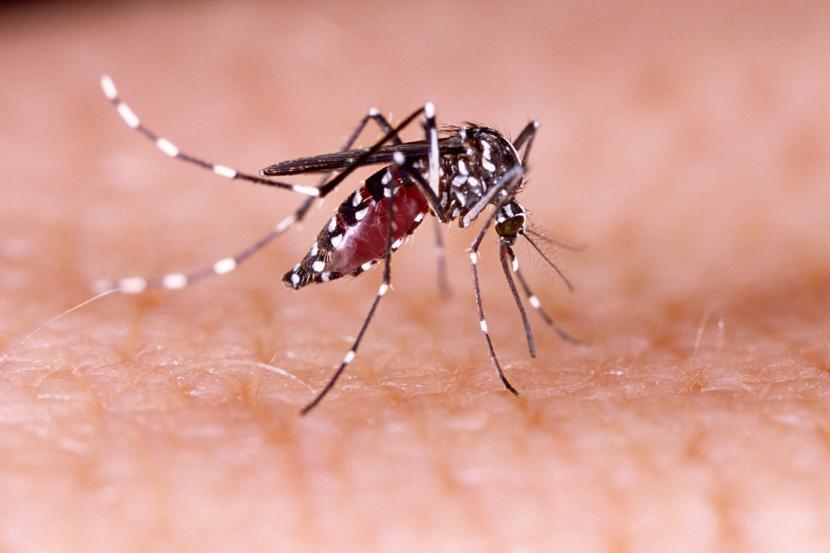Is Dengue Fever Just Another Flu?

Dengue fever is a mosquito-borne illness in humans that usually occurs in most tropical areas of the world. Dengue fever is also known as the “breakbone fever” or “dandy fever” because of the severe joint and muscle pain experienced by the people who were infected with the virus. The same virus that causes dengue fever is related to the viruses that cause the West Nile infection and yellow fever. The Aedes aegypti mosquito transmits the dengue virus,which is very prevalent in the tropical and subtropical places of the world.
According to the World Health Organization (WHO), dengue fever affects 50-100 million people annually. When an infected female Aedes mosquito bites, it transmits the dengue virus. When a mosquito bites a person, who is infected with the dengue virus, the virus is transmitted to the mosquito, which will carry the virus and further spread the disease. The dengue virus cannot be spread directly from human contact since the virus requires a mosquito for its transmission to humans. Dengue hemorrhagic fever occurs when a person who was previously infected with a particular strain of the dengue virus is now again infected by another strain of the virus.
This disease is a very rare syndrome affecting a minuscule percentage of people. The mortality rate of dengue fever is less than 1% as it is typically a self-limiting disease. Dengue hemorrhagic fever has a mortality rate of 50% when untreated and less than 2-5% when treated.
Symptoms of Dengue Fever
The first signs and symptoms of dengue fever present themselves only after 4-6 days of being infected, although in some cases, it can last for up to 10 days. The symptoms include:
- sudden high fever
- severe headaches
- pain behind the eyes (retro-orbital)
- severe joint and muscle pains
- fatigue
- nausea
- vomiting
- anorexia
- altered sensation
- skin rashes that appear over the face, thorax, and flexor surfaces
- mild bleeding from the nose, gums, and easy bruising
Sometimes, dengue fever may be wrongly diagnosed, especially if the symptoms are mild and are similarly presenting the manifestations of other types of flu or viral infections. Serious complications may also arise in some cases. Dengue hemorrhagic fever, as already stated, is a serious complication characterized by very high fever, damage to the lymph and blood vessels, bleeding from the nose and gums, enlargement of the liver, and failure of the circulatory system. The symptoms could sometimes worsen due to massive bleeding, shock, and ultimately, death. This condition is called the "dengue shock syndrome." The people who were previously exposed to a dengue virus or those who have a weakened immune system are more susceptible to develop the dengue hemorrhagic fever.
Diagnosing Dengue Fever
Dengue fever is not contagious. Therefore, it cannot be spread from person-to-person. The types of dengue viruses require a vector, which in this case, is a mosquito. The virus has to mature within the mosquito in order to effectively transmit itself to humans. Subsequently, when a mosquito that is infected with the dengue virus bites a human, the dengue virus can enter the human blood and cause havoc. The incubation period can be about 4 to 7 days, while the symptoms could take about 4 to even 15 days to appear. The disease in most cases could last for about 3 to 10 days. However, in some rare cases, it could even take longer.
You should immediately consult a doctor if you have a fever or experiencing flu-like symptoms after traveling to areas where dengue fever is endemic. A complete blood test with a metabolic panel along with coagulation studies is done to check for the presence of the virus or antibodies against the virus. Depending on the patient's symptoms, along with blood and urine cultures, a spinal tap is also done, which helps to differentiate dengue fever from other diseases. In general, patients with dengue fever will have a significantly low total white blood cell (WBC), neutrophil, and platelet counts.
If the hematocrit levels are raised, it is an indication of hemoconcentration, which precedes shock. Therefore, patients with increased hematocrit levels are monitored on a 24-hour basis to rule out dengue hemorrhagic fever, and on a 3-4 hourly basis in patients who have severe dengue hemorrhagic fever.
Treatment for Dengue Fever
Although there is no current specific antiviral medication to treat dengue, the type of medication given is only symptomatic and supportive. Drinking plenty of fluids and adequate bed rest is recommended. The analgesic acetaminophen is administered to relieve pain, lethargy, malaise, and fever. Medicines such as aspirin, other salicylates, and nonsteroidal anti-inflammatory drugs (NSAIDs) should be avoided as they could worsen the bleeding. Intravenous volume replacement is required in patients with dengue hemorrhagic fever or dengue shock syndrome.
Preventing Dengue Fever
There is no vaccine to prevent dengue fever yet. A vaccine for a single strain can provide immunity against that particular strain, but it increases the risk of getting infected by the other three, leading to dengue hemorrhagic fever, which is more dangerous. Vaccines providing immunity against all three viruses are in the pipeline, which will prove to be a major boon to mankind. The best way to prevent the acquisition of this disease is to avoid getting bitten by a mosquito. If one cannot avoid traveling to areas where the strains of the dengue virus are endemic, he or she can use certain strategies that include the use of mosquito repellents containing N,N-diethyl-3-methylbenzamide (DEET) for protection.
Travelers can also wear protective clothing, preferably those that can be applied with an insecticide called permethrin. Remaining inside air-conditioned areas as well as using indoor sprays are some of the measures taken to avoid mosquito bites. Mosquito nets are not really useful in this case as the Aedes mosquito is a day-biting mosquito. People can also try and get rid of places where the mosquitoes breed, such as flower pots, old tires, or any places that can collect rain water are needed to be cleared. Water should not be left stagnant, as this is a good breeding ground for the mosquitoes. An infected person should also be protected from mosquitoes as this could spread the infection to the others around both within the family and outside the household. Efforts should also to be taken by the government to eradicate the mosquito population altogether.
Sprays that kill mosquitoes are not very effective since mosquitoes need to be killed in their larval stage. Proper sanitation and appropriate disposal or usage of larvicides can help in the eradication of these mosquitoes. Unfortunately, the increasing urbanization that leads to overcrowding in some countries is making the ground conducive for mosquitoes to breed. Moreover, global environmental changes are equipping these mosquitoes to survive adverse conditions.
Lastly, international travelers who are already affected with the disease are also responsible for infecting the mosquitoes that are previously free from the virus. WHO statistics indicates that the dengue virus has been reported all throughout the world even in areas where previously it had never been detected. Global warming is also contributing to the mosquito population as warmer climates are more conducive to the mosquitoes' breeding and survival.
The life cycle of the dengue virus requires both humans and mosquitoes for its survival. Both of the Aedes aegypti and Aedes albopictus species of mosquito are responsible for transmitting the virus to the humans. There are four serotypes of the dengue virus that belong to the Flaviviridae family. All four of them are different from each other. If a person develops immunity against one, he or she can still be affected by the remaining three.














